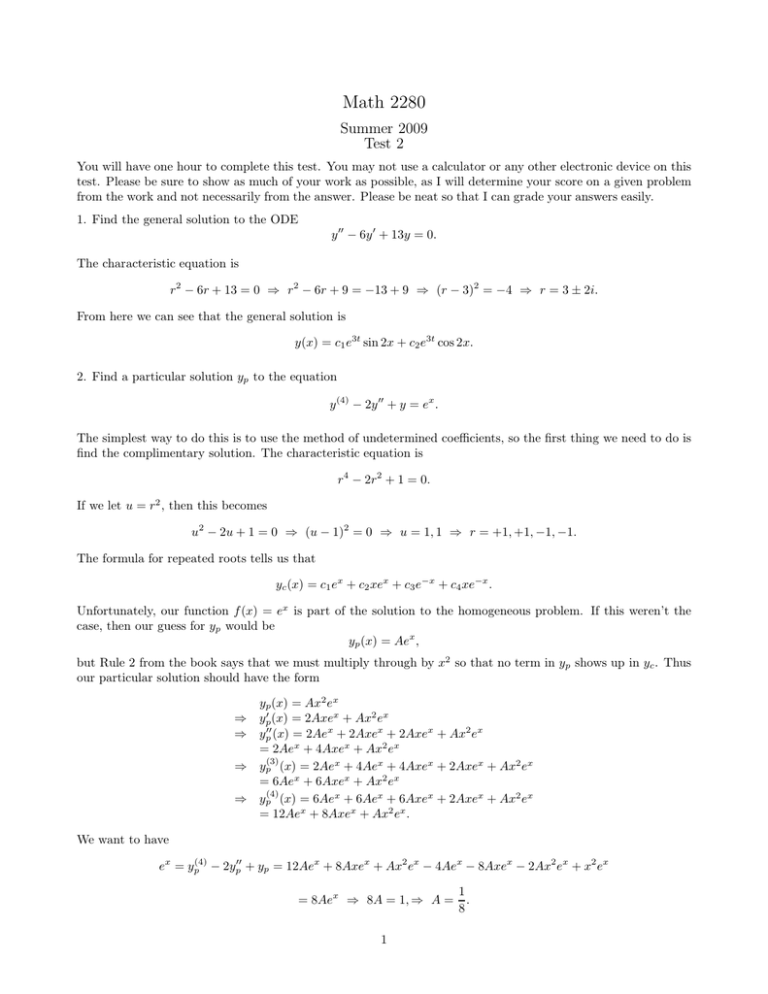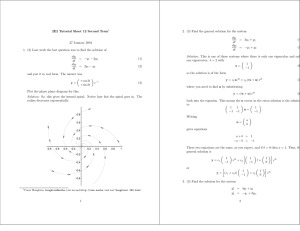Math 2280 Summer 2009 Test 2
advertisement

Math 2280 Summer 2009 Test 2 You will have one hour to complete this test. You may not use a calculator or any other electronic device on this test. Please be sure to show as much of your work as possible, as I will determine your score on a given problem from the work and not necessarily from the answer. Please be neat so that I can grade your answers easily. 1. Find the general solution to the ODE y ′′ − 6y ′ + 13y = 0. The characteristic equation is r2 − 6r + 13 = 0 ⇒ r2 − 6r + 9 = −13 + 9 ⇒ (r − 3)2 = −4 ⇒ r = 3 ± 2i. From here we can see that the general solution is y(x) = c1 e3t sin 2x + c2 e3t cos 2x. 2. Find a particular solution yp to the equation y (4) − 2y ′′ + y = ex . The simplest way to do this is to use the method of undetermined coefficients, so the first thing we need to do is find the complimentary solution. The characteristic equation is r4 − 2r2 + 1 = 0. If we let u = r2 , then this becomes u2 − 2u + 1 = 0 ⇒ (u − 1)2 = 0 ⇒ u = 1, 1 ⇒ r = +1, +1, −1, −1. The formula for repeated roots tells us that yc (x) = c1 ex + c2 xex + c3 e−x + c4 xe−x . Unfortunately, our function f (x) = ex is part of the solution to the homogeneous problem. If this weren’t the case, then our guess for yp would be yp (x) = Aex , but Rule 2 from the book says that we must multiply through by x2 so that no term in yp shows up in yc . Thus our particular solution should have the form yp (x) = Ax2 ex ⇒ yp′ (x) = 2Axex + Ax2 ex ⇒ yp′′ (x) = 2Aex + 2Axex + 2Axex + Ax2 ex = 2Aex + 4Axex + Ax2 ex (3) ⇒ yp (x) = 2Aex + 4Aex + 4Axex + 2Axex + Ax2 ex = 6Aex + 6Axex + Ax2 ex (4) ⇒ yp (x) = 6Aex + 6Aex + 6Axex + 2Axex + Ax2 ex = 12Aex + 8Axex + Ax2 ex . We want to have ex = yp(4) − 2yp′′ + yp = 12Aex + 8Axex + Ax2 ex − 4Aex − 8Axex − 2Ax2 ex + x2 ex = 8Aex ⇒ 8A = 1, ⇒ A = 1 1 . 8 Therefore, 1 2 x x e . 8 yp (x) = 3. Given the system of equations x′ = y , y′ = x find a second order equation for x and then solve it to find a formula for x and y. Taking a derivative of the first equation, we find that x′′ = y ′ = x or x′′ − x = 0. The cahracteristic equation is r2 − 1 = 0 ⇒ r = ±1. This tells us that x(t) = c1 et + c2 e−t . Now we use the first equation again to find that y(t) = x′ (t) = c1 et − c2 e−t . 4. Suppose that we are given 2-dimensional vector functions ~x1 (t) and ~x2 (t) such that x2 (t) = c~x1 (t) for some scalar c. Show that the Wronskian of ~x1 (t) and ~x2 (t) must be zero. Let us assume that ~x1 (t) = x11 (t) x21 (t) ~x2 (t) = cx11 (t) cx21 (t) . Then since ~x2 (t) = c~x1 (t), we have that If we calculate the Wronskian we have x (t) W (t) = 11 x21 (t) . cx11 (t) = cx11 (t)x21 (t) − cx11 (t)x21 (t) = 0. cx21 (t) 5. Find the general solution to the system of equations −3 4 ~x′ = ~x. 6 −5 As always, our first step is to find the eigenvalues of the coefficient matrix. We must have 3−λ 4 = (3 − λ)(−5 − λ) − 24 = 15 + 3λ + 5λ + λ2 − 24 0 = 6 −5 − λ = λ2 + 8λ − 9 ⇒ λ2 + 8λ + 16 = 9 + 16 ⇒ (λ + 4)2 = 25 ⇒ λ = −4 ± 5 = 1 or − 9. In this case we have real, distinct eigenvalues, but we still need to find the corresponding eigenvectors. For λ = 1 we have −4 4 1 −1 1 A−I = ∼ ⇒ a = b ⇒ ~v1 = . 6 −6 0 0 1 For λ = −9 we have A + 9I = 6 6 4 4 ∼ 1 0 2 3 0 2 2 ⇒ a = − b ⇒ ~v2 = 3 −2 3 . Therefore, the general solution to the problem is ~x(t) = c1 e t 1 1 + c2 e −9t −2 3 . 6. Find the general solution to the system of equations 7 1 ~x′ = ~x. −4 3 We want 7−λ 1 0 = −4 3 − λ = (7 − λ)(3 − λ) + 4 = 21 − 7λ − 3λ + λ2 + 4 = λ2 − 10λ + 25 = (λ − 5)2 ⇒ λ = 5, 5. In this case we have a repeated eigenvalue, so we must find out how many linearly independent eigenvectors correspond to λ = 5. We have 1 −1 2 1 1 12 . ⇒ a = − b ⇒ ~v1 = A − 5I = ∼ 2 0 0 −4 −2 2 Unfortunately, there is only one linearly independent eigenvector corresponding to λ = 5, so we must find one generalized eigenvector. Therefore, we solve .. .. 1 1 1 1 1 1 . −1 1 2 . − 2 2 b − ⇒ ~ v = . ∼ ⇒ a = − 2 . . −3 2 2 −4 −2 .. 2 0 0 .. 0 Our solution is ~x(t) = c1 e5t~v1 + c2 e5t (~v2 + t~v1 ). 7. Suppose that the coefficient matrix for a homogeneous linear system is A= −1 1 1 1 1 0 0 3 −1 1 1 1 −1 . Find a fundamental matrix and use it to find a solution satisfying the initial value ~x(0) = [3 − 2]T . We are given the matrix A in diagonalized form, so we can quickly read off its eigenpairs, which are −1 1 1, , 3, . 1 1 From here we can assemble our fundamental matrix: −et Φ(t) = et We also have Φ(0) = −1 1 1 1 so the solution is . ⇒ Φ−1 (0) = − 1 2 1 2 ~x(t) = Φ(t)Φ−1 (0)~x0 = − 1 =− 2 −et et e3t e3t e3t e3t 1 −1 −1 −1 , −et e3t 1 −1 3 et e3t −1 −1 −2 t 3t 1 −5e − e 5 . =− 5et − e3t −1 2 3 8. With A being the same matrix as in the previous problem, use the variation of parameters formula Z ~xp (t) = Φ(t) Φ−1 (t)f~(t) dt to find a particular solution to the problem ~x′ (t) = A~x + [0, 3]T . Since we already have Φ(t), we must now invert it. From the cofactor formula for the inverse of a 2 × 2 matrix we find 3t 1 1 e−t −e−t e −e3t . = − Φ−1 (t) = −2e4t −et −et 2 −e−3t −e−3t Multiplying by f~(t), we get Φ −1 1 (t)f~(t) = − 2 e−t −e−3t −e−t −e−3t Z 1 − 2 −3e−t −3e−3t e3t e3t 0 3 1 =− 2 −3e−t −3e−3t . = Next we integrate: and finally we multiply by Φ(t): 3 −et ~xp (t) = et 2 −e−t − 31 e−3t 3 dt = 2 3 = 2 , 3 = 2 −e−t − 31 e−3t 1 − 31 −1 − 13 2 3 − 34 1 −2 . 9. Find all of the fixed points of the system For a point (x, y) to be a fixed point we must have dx dt dy dt = 1 − y2 . = x + 2y dx dt (x,y) = dy dt (x,y) = 0. If dx dt = 0, then 1 − y 2 = 0, so y = ±1. If dy dt = 0, then x + 2y = 0 or x = −2y. Therefore, we have two fixed points, one at (−2, 1) and another at (2, −1). 10. Classify the fixed point at (0, 0) for the system ′ x =y y ′ = −5x + 4y as either stable, unstable, or asymptotically stable. Give a short justification of your answer. The coefficient matrix for the system is A= 0 1 −5 4 . Its eigenvalues must satisfy −λ 1 0 = −5 4 − λ = −λ(4 − λ) + 5 = −4λ + λ2 + 5 ⇒ λ2 − 4λ + 4 = −5 + 4 ⇒ (λ − 2)2 = −1 ⇒ λ = 2 ± i. Since the eigenvalues have positive real parts, the fixed point at the origin is unstable. 4




